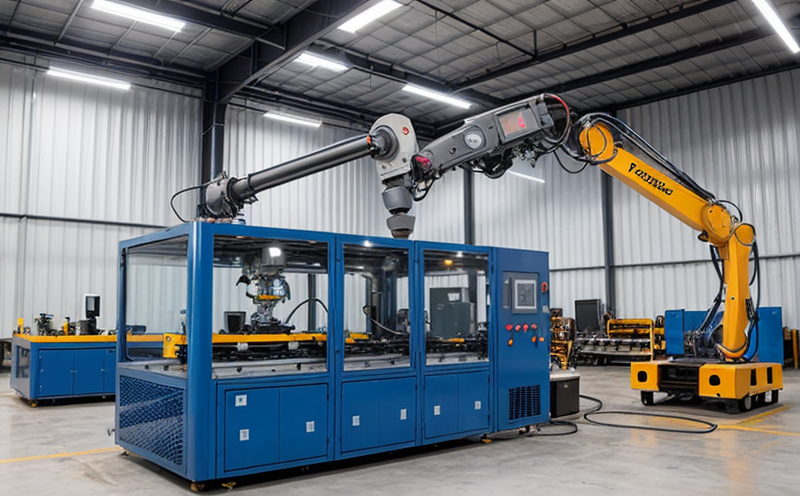ISO 20155 Robot Welding System Performance Testing
The ISO 20155 standard provides a comprehensive framework for testing robot welding systems, ensuring that they meet stringent performance criteria in terms of accuracy, repeatability, and reliability. This service is critical for industrial manufacturing and processing as it guarantees the quality and efficiency of robotic welding processes.
Robot welding has become an indispensable part of modern manufacturing due to its precision and speed. However, the complexity of robot systems means that their performance must be rigorously tested before deployment in production environments. ISO 20155 addresses this need by offering a standardized approach to testing robot welding systems.
The standard defines specific test parameters such as path accuracy, travel speed, positioning repeatability, and cycle time. It also provides guidelines for the preparation of specimens, which are essential for accurate testing. The use of ISO 20155 ensures that all parties involved in robotic welding can rely on consistent and comparable results.
Our laboratory uses advanced instrumentation to conduct these tests. This includes high-precision measuring devices capable of capturing minute movements during the welding process. The data collected is then analyzed using sophisticated software tools to ensure compliance with ISO 20155 standards.
The testing process involves several key steps. First, a robotic arm equipped with a welder and camera is calibrated according to ISO 20155 guidelines. Next, test specimens are prepared in accordance with the standard's specifications. These specimens undergo multiple rounds of welding under various conditions to evaluate different aspects of system performance.
The results from these tests provide valuable insights into the capabilities and limitations of robotic welding systems. They help manufacturers identify areas for improvement and ensure that their equipment meets industry standards. By adhering strictly to ISO 20155, we can provide accurate and reliable testing services that are crucial for maintaining high-quality manufacturing processes.
The importance of ISO 20155 cannot be overstated in today’s competitive market where quality and efficiency are paramount. Compliance with this standard not only enhances the reputation of manufacturers but also ensures safer and more effective robotic welding operations.
Benefits
Conducting ISO 20155 robot welding system performance testing offers numerous benefits to industrial manufacturing and processing facilities:
- Enhanced Quality Control: By adhering strictly to the prescribed standards, manufacturers can ensure that their robotic welding systems meet the highest quality benchmarks.
- Increased Efficiency: The rigorous testing process helps identify inefficiencies in the system, allowing for targeted improvements and optimizations.
- Better Safety Standards: Robotic welding operations are inherently dangerous; ensuring compliance with ISO 20155 reduces risks associated with improper setup or operation of systems.
- Cost Savings: Early detection of issues through thorough testing can prevent costly downtime and repairs later on in the production cycle.
- Regulatory Compliance: Many industries are subject to strict regulatory requirements; ISO 20155 provides a robust framework for meeting these standards.
- Innovation Support: With detailed data about system performance, manufacturers can innovate and develop next-generation robotic welding solutions.
- Customer Satisfaction: Ensuring consistent quality across all products builds trust with clients who rely on reliable manufacturing processes.
The benefits of ISO 20155 robot welding system performance testing extend beyond just the manufacturer; they also contribute positively to the overall ecosystem of industrial manufacturing and processing. By fostering a culture of excellence in robotic welding, we help create more robust supply chains that are better equipped to meet global demand.
Quality and Reliability Assurance
The quality and reliability assurance process for ISO 20155 robot welding system performance testing is designed to provide confidence in the accuracy, repeatability, and durability of robotic welding systems. This section outlines our approach to ensuring that every test conducted adheres strictly to international standards.
Our laboratory employs a multi-step methodology to achieve this goal:
- Calibration: Prior to any testing, the robotic arm is calibrated according to ISO 20155 guidelines. This ensures that all subsequent measurements are accurate and consistent.
- Specimen Preparation: Test specimens are prepared meticulously following strict protocols outlined in the standard. This includes selecting appropriate materials and dimensions for optimal results.
- Testing Protocols: The testing process follows a predefined sequence of tasks designed to evaluate critical parameters like path accuracy, travel speed, positioning repeatability, and cycle time.
- Data Collection: Advanced instrumentation captures detailed data during each phase of the test. This information is crucial for comprehensive analysis and interpretation.
- Analytical Methods: Data collected from testing is analyzed using state-of-the-art software tools that are specifically designed to meet ISO 20155 requirements.
- Reporting: Comprehensive reports are generated based on the analyzed data, providing clear insights into system performance. These reports serve as valuable resources for continuous improvement and regulatory compliance.
This structured approach ensures that every aspect of robotic welding systems is thoroughly evaluated against international standards. The result is a high level of assurance regarding both quality and reliability in industrial manufacturing processes.
Use Cases and Application Examples
| Use Case | Description |
|---|---|
| Automotive Manufacturing: | Ensuring precise welds in car body structures. |
| Electronics Assembly: | Guaranteeing secure connections between components. |
| Metal Fabrication: | Achieving strong joints for structural integrity. |
| Shipbuilding: | Creating robust hulls with minimal defects. |
| Appliance Manufacturing: | Producing durable appliances with seamless finishes. |
| Machinery Production: | Building reliable machinery with consistent weld quality. |
The application of ISO 20155 robot welding system performance testing is widespread across various industries. From automotive manufacturing to electronics assembly, each sector relies on robotic welding for critical processes that demand precision and reliability. By adhering strictly to these standards, manufacturers can ensure consistent quality throughout their production lines.





